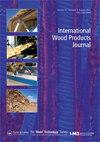本期
IF 0.9
Q2 MATERIALS SCIENCE, PAPER & WOOD
引用次数: 0
摘要
木材聚合物复合材料目前吸引了大量研究,以利用源自天然材料的粘合剂。紫外线稳定性和复合材料的最终命运都很重要,因此必须评估其生物降解为无害成分的能力。在这篇论文中,印度特兹普尔大学的Tarun Kumar Maji和他的团队研究了使用松香衍生物作为粘合剂制成的WPC的潜力。本文章由计算机程序翻译,如有差异,请以英文原文为准。
In this Issue
Wood polymer composites currently attract much research to utilise binders derived from natural materials. UV stability is important as well as the final fate of the composites so their ability to biodegrade into harmless components must be assessed. In this paper, Tarun Kumar Maji and his team at Tezpur University in India have investigated the potential of WPCs made using rosin derivatives as binders.
求助全文
通过发布文献求助,成功后即可免费获取论文全文。
去求助
来源期刊

International Wood Products Journal
MATERIALS SCIENCE, PAPER & WOOD-
CiteScore
2.40
自引率
0.00%
发文量
27
 求助内容:
求助内容: 应助结果提醒方式:
应助结果提醒方式:


